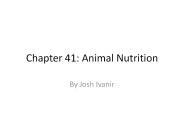Chapter 34: Vertebrates - PowerPoint PPT Presentation
1 / 12
Title:
Chapter 34: Vertebrates
Description:
Lampreys (oldest living lineage of vertebrates) are a parasite in marine ... Lamprey cartilage is unlike most vertebrae in that it contains no collagen, it ... – PowerPoint PPT presentation
Number of Views:133
Avg rating:3.0/5.0
Title: Chapter 34: Vertebrates
1
Chapter 34 Vertebrates
- By Amelia Abuzuhri and
- Katherine Duffy
2
Section 1
- Name is derived from the series of bones that
make up vertebral column or backbone. - Vertebrates are members of Chordates, which is a
group made up of vertebrates and some closely
related invertebrates. - Chordates are bilaterian animals and belong to
clade known as Deuterostomia. - Chordates are named for a skeletal structure, the
notochord.
3
Section 1 Characters of Chordates
- Notochord is longitudinal, flexible rod located
between digestive tube and nerve cord. Present in
all chordate embryos and some adult. - Composed of large fluid filled cells enclosed in
fibrous tissue. Provides skeletal support
throughout length of chordate. - Notochord provides firm but flexible support
against which the muscles work during swimming. - In humans the notochord is made up of gelatinous
disks between vertebrae.
4
Characters Notochord cont.
5
CharactersDorsal, Hollow Nerve Cord
- Nerve Cord develops from plate of ectoderm,
during the embryo stage, it rolls into tube
located located dorsal to notochord. - Dorsal is a hollow nerve cord which is unique to
chordates other animal phyla have solid nerve
cords and are located ventrally. - This nerve cord of the embryo later develops into
the central nervous system--gt brain and spinal
cord.
6
Characters Pharyngeal Slits or Clefts
- During embryonic stage in chordates there are a
series of pouches separated by grooves along the
pharynx, Pharyngeal clefts. - These grooves later develop into Pharyngeal
Slits which allow water to enter the mouth
without passing through the digestive system. - In most vertebrates these slits are modified for
gas exchange and are known as gill slits. - However in tetra pods, clefts dont develop into
slits but into other structural parts.
7
Lancelets
- Bladelike shape and lack a backbone, but do have
notochord, dorsal, hollow nerve cord, pharyngeal
slits, and post-anal tail. - Adults can reach up to 5cm, closely resemble
idealized chordate, and are members of subphylum
Cephalochordata. - Burrow in sand of seafloor and leave cilia
exposed to obtain nutrients. Use contractions of
muscles to swim.
8
Tunicates
- Subphylum?Urochordata are more closely related
to chordates than Lancelets. Chordates
characteristics more apparent in larvae stage. - Finds substrate in water and attaches and looses
all chordate characteristics.
9
Section 2
- Craniates? chordates with a head.
- Have 2 Hox gene clusters (lancelets/tunicates
have 1) and have a neutral crest. - Neutral crest? collection of cells near dorsal
margins in embryo. Gives rise to various
structures in body. - More active, higher metabolic rate, and more
extensive muscular system. - Hagfish?least developed craniate. Have skull but
lack jaw and vertebrae are snakelike. - Secrete a slime to drive away predators which
sticks to gills of predator then suffocating it.
10
Craniates
- Haikouella craniate discovered in 1999 in
southern China. - Hagfish is in the class of Myxini.
11
Section 3
- Vertebrates branched off from other craniates,
and transcribed new gene factors? Dlx family
resulted in more genetic complexity (extensive
skull/backbone). - Lampreys (oldest living lineage of vertebrates)
are a parasite in marine/freshwater environments
with clamping mouths that tend to feed on fish
blood. - Have relatively short life span, after they
reproduce they die within a few days. - Lamprey cartilage is unlike most vertebrae in
that it contains no collagen, it is a stiff
protein matrix.
12
Conodonts/Orgins of Bone and Teeth
- Conodonts were a slender, soft-bodied vertebrate
with prominent eyes and teeth. - Teeth were barbed like books made of dental
tissue that were mineralized. Gave way to
discovering vertebrates without jaws, but with
teeth. - Mineralization was only discovered after lampreys
were, this gave way to divergence of
unmineralized skeleton to mineralized.































